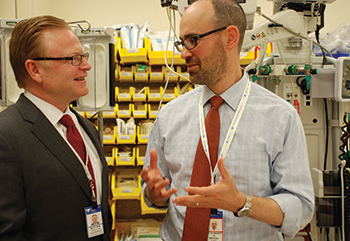
Matthew Comerford, vice president, Internal Consulting Group (left), and Ian Schwartz, MD, executive director, Performance Management, lead clinical redesign efforts across Yale New Haven Health.
Q&A with Ian Schwartz, MD, executive director, and Matthew Comerford, vice president
Yale New Haven Health continually strives to make patient care better, safer and more efficient. These three qualities create greater healthcare value for patients. This is where clinical redesign takes an active role, helping departments or areas evaluate and improve their functions, processes and results. Clinical redesign is a service under the leadership of Ian Schwartz, MD, executive director, Performance Management, provided through the Internal Consulting Group, a systemwide department headed by Matthew Comerford, vice president. Both answered a few questions about clinical redesign at YNHHS.
What is clinical redesign?
IS: Clinical redesign is an engine to deliver results across the health system. The teams that conceive clinical improvements and drive process change are our front-line providers and interdisciplinary clinical teams. This is their effort and the results are their own. Clinical redesign itself is a rapid and focused methodology that harnesses ideas and leverages a strong partnership with Epic/ Joint Data Analytics (JDAT) to make the needed improvements. Our team works with clinical staff to take a fresh look at how care is delivered and how it can be improved. The result is evidence-based, clinically excellent, patient-focused care that is delivered safely and efficiently.
MC: I'd like staff to know that clinical redesign is a service for them to use. When you want to know how to do something better, your go-to people are the ones who are doing the work. They're ones who know best. Our clinical redesign team acts as internal consultants to help guide them through the steps it takes to create change and make it stick. That's why we've given the title of "consultant" to many members of our team.
How does the clinical redesign team work with staff?
MC: We work with other staff according to our motto: Rethink, Realign, Redesign. We help staff rethink how care is delivered, then realign resources to better meet patients' needs, and finally, redesign the processes that are crucial to the successful, sustainable delivery of that care.
What are some examples of clinical redesign cases?
MC: Last year, we redesigned our own approach to clinical redesign. We wanted to fast-track our work, and implement realistic, doable changes that would be long-lasting. So we prioritized our projects, selected the top 13 and put them on 90- day timelines. Of the 13 projects launched and completed last year, 84 percent displayed positive trends. Projects, or cases as we call them, included eliminating 7,700 inpatient days, removing more than 3,600 instruments from surgical trays and decreasing the total number of duplicate lab tests by almost 55 percent and point-of-care labs by 42 percent.
IS: Each of those examples shows how clinical redesign enhances or improves patient care – whether it's through shorter hospital stays, fewer unnecessary tests or higher quality care.
That's what drives clinical redesign. When cost savings result, that's an additional win. Keep in mind that clinical redesign contributes to our work by adding value to lives of our patients. It also furthers the Institute for Healthcare Improvement's "Triple Aim" by improving the patient experience of care, improving the health of populations and reducing the per capita cost of health care.
Can anyone submit an idea for a clinical redesign case?
IS: Yes. Share your suggestions about improving care or processes with your manager or director so they can reach out to the clinical redesign team.
MC: Our efforts are only made more successful by the ideas that come directly from our frontline staff. They understand the problems and have great insight in how to get them solved.